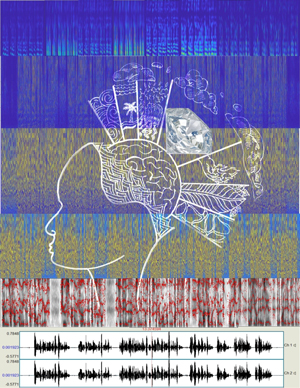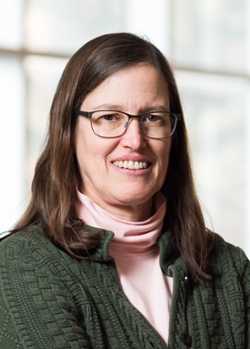Carney Lab
Auditory Neuroscience
A new Cloud-based version of our Auditory-Nerve and Midbrain simulation code, UR_EAR, is now available at: https://urhear.urmc.rochester.edu
This Matlab Web App provides visualizations of population AN and IC models. Responses to several stimuli are available, including uploaded audiofiles.
Additionally, 3 downloadable versions are available at https://osf.io/6bsnt/ :
1) Open source code for the Matlab web app (runs in Matlab versions R2018b and later),
And two standalone versions, which will run even without Matlab:
2) Matlab "installer" (executable) version for Windows
3) Matlab "installer" (executable) version for Mac

Entry in “Art of Science” Competition from Ben Richardson (BME Undergrad in Carney Lab). Inspired by the following quote: “Diamonds are found only in the dark bowels of the earth; truths are found only in the depths of thought. It seemed to him that after descending into those depths after long groping in the blackest of this darkness, he had at last found one of these diamonds, one of these truths, and that he held it in his hand; and it blinded him to look at it."
-Victor Hugo, Les Miserables
We study hearing! We’re interested in the incredible ability of the healthy auditory system to detect and understand sounds, even in noisy backgrounds. We’re also interested in understanding how the auditory system encodes speech sounds. The holy grail of hearing science is to help listeners with hearing loss, and the biggest challenge for these listeners is understanding speech in noise.
We use many experimental and computational techniques in an effort to better understand hearing and hearing loss. We combine neurophysiological, behavioral, and computational modeling techniques towards our goal of understanding the neural mechanisms supporting perception of complex sounds. Computational modeling bridges the gap between our behavioral and physiological studies. For example, using computational models based on neural recordings, we make predictions of behavioral abilities. These predictions can be directly compared to actual behavioral results. The cues and mechanisms used by our computational models can be varied to test different hypotheses for neural coding and processing.
We are also interested in applying our results to the design of novel signal-processing strategies to enhance speech, especially for listeners with hearing loss. By identifying the acoustic cues involved in the detection of signals in noise and in coding speech sounds, we can devise strategies to preserve, restore, or enhance these cues for listeners with hearing loss.

Laurel Carney, Ph.D.
Principal Investigator
- Otoacoustic emissions but not behavioral measurements predict cochlear nerve frequency tuning in an avian vocal communication specialist.; eLife; Vol 13. 2025 Jun 02.
- Chirp sensitivity and vowel coding in the inferior colliculus.; Hearing research; Vol 463, pp. 109307. 2025 May 14.
- Mechanisms of Tone-in-Noise Encoding in the Inferior Colliculus.; The Journal of neuroscience : the official journal of the Society for Neuroscience. 2025 May 07.
- Forward masking in the inferior colliculus: Dynamics of discharge-rate recovery after narrowband noise maskers.; The Journal of the Acoustical Society of America; Vol 157(5), pp. 3680-3693. 2025 May 01.
- Outer hair cells stir cochlear fluids.; eLife; Vol 13. 2025 Jan 16.
- A fast and accurate approximation of power-law adaptation for auditory computational models.; The Journal of the Acoustical Society of America; Vol 156(6), pp. 3954-3957. 2024 Dec 01.
News
June 27, 2025
Laurel Carney receives national mentorship award
August 8, 2019
Professor Carney receives Kearns Faculty Mentoring and Teaching Award for commitment to first-generation, minority students
July 15, 2019
Professor Carney receives renewed NIH funding
October 10, 2018
Professor Carney will speak at Rochester Science Cafe
Contact Us
Carney Lab
MC 5-6483
601 Elmwood Ave
Rochester, NY 14642










